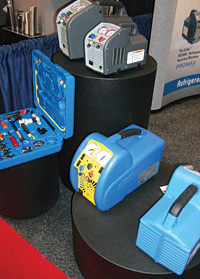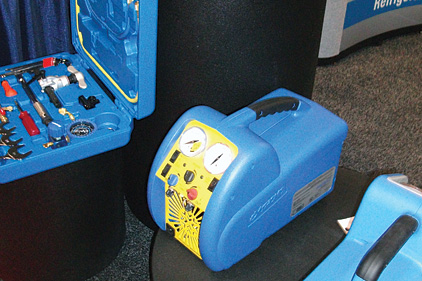With all the talk about reclaim and new non-f-gas refrigerants, it is sometimes easy to overlook an important and still vital sector of the HVACR industry: the recovery and recycling of f-gas refrigerants extracted from a system.
The arrival of the Montreal Protocol in the late 1980s mandated U.S. Environmental Protection Agency (EPA) certification in proper recovery procedures as well as having equipment for the process.
By definition, the EPA describes recovery as the “removal of refrigerant in any condition from an appliance and storage in an external container without necessarily testing or processing it in any way.”

|
| This display at the AHR Expo in New York City earlier this year shows the continued interest in recovery equipment – especially newer models. |
Recycle is defined by the EPA as “extracting refrigerant from an appliance and cleaning it for reuse without meeting all of the requirements for reclamation. In general, recycled refrigerant is refrigerant that is cleaned using oil separation and single or multiple passes through devices, such as replaceable core filter-driers, which reduce moisture, acidity, and particulate matter.”
What has changed over the past 25 years or so is the recovery equipment. First-generation equipment has now more than likely worn out. (Typically, life spans are about 10 years, according to many involved with such equipment.) And the latest generation of such equipment is a considerable improvement over that of the first generation.
So, here are some things to look for in the latest recovery equipment. Listed below is equipment that demonstrates each specific aspect of the recovery process, with the understanding that quality equipment meets more than just one aspect. Readers are encouraged to contact manufacturers directly to discuss specific equipment needs.
Cylinders
Recovery units come in both single-cylinder and twin-cylinder units. One advocate of the twin approach is Mastercool Inc. Chris Carroll, sales manager, said, “Mastercool’s Twin Turbo offers new technology and is designed with a double piston compressor for maximum recovery at a high speed. In addition, the unit is cooled by a very large fan and condenser. The double piston compressor design provides exceptional overall performance and value to the HVAC technician.”
Simplicity
Finding the balance between doing everything a recovery unit should do as easily and efficiently as possible is another consideration when comparing recovery equipment. Steven Secord of Refco Mfg. Ltd. noted the company’s OZ-4000 uses a “solenoid system design and a simple four-hose hook up. The OZ-4000 can go from the push-pull method (17 pounds per minute) to 1/2 pound per minute in vapor recovery with no hose changes and without shutting off the unit.”
Cross-Contamination
Recovery units are commonly used with more than one refrigerant or oil type, even though contractors usually have separate hoses and manifold sets for each refrigerant. Despite the bulk-purge feature used on some recovery machines, “refrigerant can get trapped inside the crankcase and bearings if the crankcase is not sealed and isolated from refrigerant, which increases cross-contamination troubles,” said Christian Pena, general manager at Appion Inc., who noted “the G5Twin and G1Single seal and isolate the crankcase from refrigerant, which provides the added benefit of lifetime lubrication.”
Oil or Oil-Less?
Using a recovery unit that runs on oil or has incorporated a more recent trend to oil-less technology is a consideration for contractors. Do-it-yourself websites are waging debates on the topic right now. For those in HVACR, the obvious answer is to consult with manufacturers and ask that question. Among advocates of the oil-less approach is CPS Products, which has a TR21 unit that uses, according to the company’s business development manager, Marjorie McAllister, a two-cylinder oil-less reciprocating compressor in what she said was a heavy-duty recovery machine.
Sizing
If contractors typically deal with residential and appliance-sized recovery jobs, a smaller unit is preferable. If the jobs are larger, then larger equipment might be preferred to ensure fast recovery. If a contractor does both, then multi-sized equipment is a must.
All jobs are different was the comment from representatives at Robinair, a division of Bosch Automotive Service Solutions, who noted their RG3 recovery unit is designed for smaller jobs. It weighs 18 pounds, an important consideration for technicians hauling such equipment to rooftops.
Manufacturers typically make it clear which applications are best for specific units. For example, Bacharach Inc. labels its FM3600 a commercial recovery machine that can recover vapor at up to 2 pounds per minute and can tolerate liquid directly through its compressor. Its large condenser ensures fast recovery in the hottest environments, the company said.
Operating
The mechanics of the unit itself, such as the efficiency of heat transfer and head pressure rating, should also be considered. That was an aspect touted by Galpa Export Corp., a Mexican company that exhibited its DVR Series of recovery machines at the 2014 AHR Expo. In a statement, the company highlighted the DVR Series’ individual valve assembly with dual-sealed valve stems that eliminates leaks, and a brazed aluminum condenser design that provides better heat transfer.
Customizing
For contractors traveling internationally, it is important to have recovery equipment from a manufacturer they can trust rather than relying on what might be available “over there,” not to mention having to pay for whatever is “over there.” That’s one reason a company like RefTec Intl. Systems LLC promotes the fact that it can build equipment to meet any specified power requirements worldwide.
Compliance
Appion’s Pena also noted, “Aside from the technology of recovery equipment, a very important detail for contractors is compliance with EPA regulations. There have been some machines sold in the marketplace that are not certified in accordance with Section 608, and that could leave a technician liable in the event of an EPA audit. Technicians should check with UL and Air-Conditioning, Heating, and Refrigeration Institute (AHRI) for listings of certified recovery equipment, and they can also locate the UL or AHRI compliance statement that must be labeled on every certified recovery machine.”
Pena noted that the EPA provides guidance online at: http://bit.ly/EPArefrigerantCompliance.
Publication date: 4/7/2014
Want more HVAC industry news and information? Join The NEWS on Facebook, Twitter, and LinkedIn today!



Report Abusive Comment